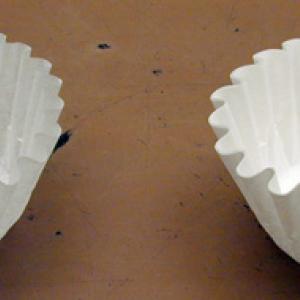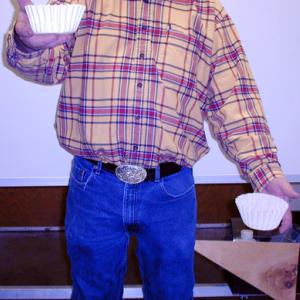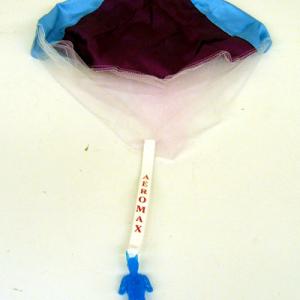College of Liberal Arts & Sciences
2C30.65 - Terminal Velocity - Coffee Filters
See also 1C20.18 in Mechanics.
The coffee filters will reach a terminal velocity in a very short time. There shape makes them particularly easy to use with the sonic sensor, as they float down with very little side to side motion.
The second picture shows the relationship between one coffee filter and four coffee filters and their velocities. If you hold the four coffee filters at approximately twice the height of one coffee filter they will hit the ground at the same time.
The parachutes can also be used as an example of terminal velocity. Fold the parachute according to the instructions and throw at the ceiling of the lecture room. The chute will unfold and quickly achieve terminal velocity.
- Sebastian Becker, Pascal Klein, and Jochen Kuhn, "Video Analysis on Tablet Computers to Investigate Effects of Air Resistance", TPT, Vol. 54, #7, Oct. 2016, p. 440.
- Elida de Obaldia, Norma Miller, Fred Wittel, George Jaimison, and Kendra Wallis, "Bridging the Conceptual Gap Between Free Fall and Drag-Dominated Regimes", TPT, Vol. 54, #4, Apr. 2016, p. 233.
- Wojciech Dindorf, "Simple Terminal Velocity Measuring Device", TPT, Vol. 49, #3, Mar. 2011, p. 190.
- Ian Lovatt and Bill Innes, "Resistance Is Not Futile: Air Resistance in an Algebra-Based Course", TPT, Vol. 43, #8, Nov. 2005, p. 544.
- Paul Gluck, "Air Resistance on Falling Balls and Balloons", TPT, Vol. 41, #3, Mar. 2003, p. 178.
- Richard A. Young, "Improving the Data Analysis for Falling Coffee Filters", TPT, Vol. 39, #7, Oct. 2001, p. 398.
- Carl Angell and Trond Ekern, "Measuring Friction on Falling Muffin Cups", TPT, Vol. 37, #3, Mar. 1999, p. 181.
- Terrence Toepker, "An Extension", TPT, Vol. 37, #3, Mar. 1999, p. 132.
- Steven Herbert and Terrence Toepker, "Terminal Velocity", TPT, Vol. 37, #2, Feb. 1999, p. 96.
- Vasilis Pagonis, David Guerra, Sean Chauduri, Brian Hornbecker, and Nathan Smith, "Effects of Air Resistance: Dropping a Series of Nested Coffee Filters", TPT, Vol. 35, #6, Sept. 1997, p. 366.
- Norman F. Derby, Robert G. Fuller, and Phil W. Gronseth, "The Ubiquitous Coffee Filter", TPT, Vol. 35, #3, Mar. 1997, p. 168.
- Neil M. Shea, "Terminal Speed and Atmospheric Density", TPT, Vol. 31, #3, Mar. 1993, p. 176.
- Frank L. Weichman and Bruno Larochelle, "Air Resistance", TPT, Vol. 25, #8, Nov. 1987, p. 505.
- Margaret Stautberg Greenwood, Charles Hanna, and Rev. John Milton, "Air Resistance Acting on a Sphere: Numerical Analysis, Strobe Photographs, and Videotapes", TPT, Vol. 24, #3, Mar. 1986, p. 153.
- Alan Mironer, "Understanding Drag", TPT, Vol. 20, #6, Sept. 1982, p. 400.
- James A. Lock, "The Author Adds Details", TPT, Vol. 20, #6, Sept. 1982, p. 400.
- James A. Lock, "The Physics of Air Resistance", TPT, Vol. 20, #3, Mar. 1982, p. 158.
- M. A. F. Gomes, "Fractal Geometry in Crumpled Paper Balls", AJP, Vol. 55, #7, July 1987, p. 649.
- Mark Peastrel, Rosemary Lynch, and Angelo Armenti Jr., "Terminal Velocity of a Shuttlecock in Vertical Fall", AJP, Vol. 48, #7, July 1980, p. 511.
- M-136: "Flat $ Bills & Coffee Filters", DICK and RAE Physics Demo Notebook.
- "Air Drag on a Falling Plastic Ball", Apparatus Notes, July 1965-December 1972.
- Robert Ehrlich, "Terminal Velocity of Falling Coffee Filters", Why Toast Lands Jelly-Side Down, p. 40 - 42.
- Charles Windsor, "Coffee Filters".
- Borislaw Bilash II and David Maiullo, "Floating Down", A Demo a Day: A Year of Physics Demonstrations, p. 31.
Disclaimer: These demonstrations are provided only for illustrative use by persons affiliated with The University of Iowa and only under the direction of a trained instructor or physicist. The University of Iowa is not responsible for demonstrations performed by those using their own equipment or who choose to use this reference material for their own purpose. The demonstrations included here are within the public domain and can be found in materials contained in libraries, bookstores, and through electronic sources. Performing all or any portion of any of these demonstrations, with or without revisions not depicted here entails inherent risks. These risks include, without limitation, bodily injury (and possibly death), including risks to health that may be temporary or permanent and that may exacerbate a pre-existing medical condition; and property loss or damage. Anyone performing any part of these demonstrations, even with revisions, knowingly and voluntarily assumes all risks associated with them.


